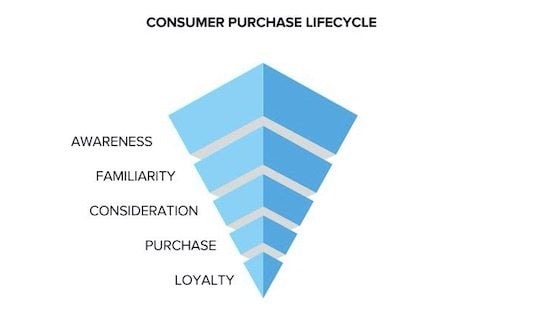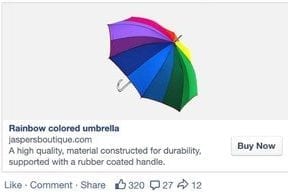
Before buying a product, consumers typically pass through multiple stages, from initial awareness, to familiarity, to consideration, and, ultimately, to purchase. Satisfied customers become loyal, hopefully.
Consumer brands can advertise to prospects on so many channels. There are seemingly countless options for targeting and for creative copy.
Facebook and Google have long been the dominant consumer advertising channels. Shoppers use both of these platforms to discover and research products. In fact, Facebook and Google accounted for 63.1 percent of U.S. digital ad spend in 2017, according to eMarketer.
But a third option, Amazon, is gaining ad share. Though Amazon currently receives only 3 percent of global display advertising, one equity analyst predicted Amazon would quadruple its advertising revenue by 2020.
It’s not easy, in other words, for brands to know where to advertise. In this post, I’ll offer guidance.
Facebook is where consumers discover products — when they are not aware of a brand or product. Because of Facebook’s extensive reach and targeting, brands can create awareness with prospecting ads and build familiarity with retargeting ads.

However, since Facebook is an established platform, competition is hot for user attention. It can be relatively expensive to reach those prospects. And since users don’t typically purchase directly on Facebook, tracking and assigning a value to the purchase path can be troublesome.
This is especially the case if the purchase ultimately happens on Amazon, which is increasingly likely.
Google is where consumers research goods by searching for a brand, a product, or a general solution. Google is most effective in the mid-to-lower portion of the purchase cycle with its search, Shopping, and remarketing ad platforms.
But Google’s platforms are limited to shoppers searching for those products. If consumers are not aware of your product or brand, it will be difficult to target them. Like Facebook, Google’s ads can be expensive as advertisers battle for competitive keywords.
Amazon
Amazon is where consumers make a purchase.
Advertisers on Google and other search engines might be aiming to aid a consumer’s search for information or knowledge, sign up for a program, or buy a product. But on Amazon, the ad focus is entirely on the shopper clicking the promotion, then clicking the “Add to Cart’” button.
This puts Amazon’s advertising capabilities at the middle section of the consumer purchase journey, where shoppers are considering alternative products and then completing the purchase. The benefits of Amazon’s platform include:
- Competitive return on ad spend. Relative to other channels, Amazon advertisers can convert shoppers at a low cost. I’m aware of one company that breaks even on AdWords and achieves a 5-to-1 return on Amazon ads.
- Short path to purchase. There’s a reason why one-half of consumers start their product searches on Amazon: There are more than 500 million products there. Consumers are almost guaranteed to find what they need. With the right keyword targeting and bidding strategy, users can easily see your ad, find your product, and make a purchase.
The drawbacks of Amazon’s ad programs stem from their relative newness. Google and Facebook have been refining and growing their ad platforms for years. Amazon ad platform is comparatively new. The drawbacks include:
- Limited ad types. Amazon offers just three ad types: Sponsored Products, Headline Search, and Product Display.
- Limited reporting. For example, there’s no option for custom report dates. That means advertisers cannot review data for exact times when trying to track the performance of a promotion.
- Lack of data. Amazon is notoriously reticent to share customer data with advertisers. There’s no retargeting capability, even though Amazon has reams of consumer purchase data that would provide rich targeting capabilities.

Amazon offers three ad types: Sponsored Products, Headline Search, and Product Display.
Which to Choose?
So how do you know what platform is right for your business? It depends on where on the purchase cycle you want to engage prospects.
Facebook’s network is the king at driving awareness for a brand, with deep interest and demographic targeting. Google’s large publishing network and analytics capabilities can push an aware prospect further down the cycle. And Amazon is where consumers go to comparison shop and complete their purchase.
Which platform to choose? For many brands, the answer is all three.




